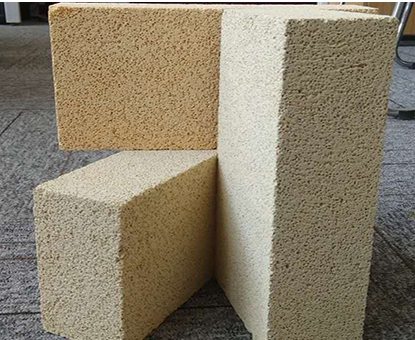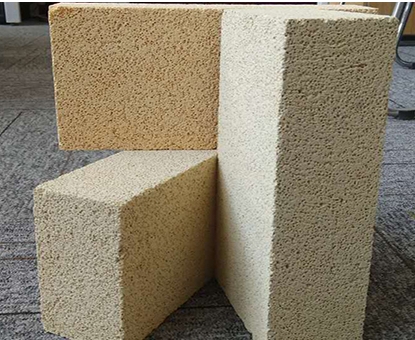- 17
- Oct
The performance and characteristics of zirconium corundum refractory bricks
The performance and characteristics of zirconium corundum refractory bricks

Zirconium corundum odadavamlı kərpiclər are made from industrial alumina and zircon sand. According to the manufacturing process, zirconium corundum refractory bricks can be divided into fused zirconium corundum bricks and sintered zirconium corundum bricks.
Henan odadavamlı kərpic istehsalçısı, odadavamlı top istehsalçısı, yüngül izolyasiya kərpic, Zhengzhou Huaxin Yüksək Temperaturlu Material Co., Ltd.
Fused zirconium corundum brick is commonly called white iron brick, also known as corundum clinoptilolite brick. The main chemical composition is 350%~70% Al2O, 220%~40% ZrO, and the rest is SiO2. The main mineral components are zircon (ZrO2), corundum (α-Al2O3) and glass phase. Zircon crystals form the skeleton of the brick. Zirconia has a high melting point (2715°C) and good chemical stability. Zircon is very corrosive to acidic and alkaline media, especially to molten glass.
Fused zirconium corundum bricks are used in glass furnaces and other industrial furnaces. The glass melting furnace components used in the glass melting furnace include upper pool wall, small furnace flat arch, small furnace pier, tongue arch and breast wall. The following issues should be paid attention to in the use of fused zirconia corundum bricks.
① Irregular changes in thermal expansion. The expansion curve of the fused zirconia corundum brick shows an abnormal section near 1000 ℃. Reversible changes occur inside the Zr02 crystal, and the volume changes greatly. Therefore, bricks containing ZrO2 should not be used in places where the temperature fluctuates sharply around 1000°C. In the oven, the temperature change between 900~1150℃ should not be too large, generally should not exceed 15℃/h, and the temperature should be raised steadily. Some places should be protected from cold wind, and other bricks should be used to prevent them from cracking.
②Shrinkage. In the pouring process, shrinkage holes often appear, the brick body has many pores, and the compactness is poor. Therefore, when the wall of the glass melting pool is constructed, the shrinkage cavity will develop in the direction of the kiln. If the gate faces outwards, when the brick body is eroded to a very thin layer, it will cause glass leakage accidents. It is used in the upper flame space of the kiln, with a long service life, and there is no problem of glass liquid escape. Therefore, the casting port is used outwards to extend the service life.
③ Eutectic. When the fused zirconia corundum brick is in contact with the clay brick, eutectic will appear at 1300℃. Therefore, when choosing refractory materials, serious eutectic phenomena of the two materials should be avoided.
Sintered zirconium corundum brick is also called ceramic bonded aluminum silicon zirconium brick. Compared with fused zirconium corundum bricks, sintered zirconium corundum bricks have similar chemical composition, but have the advantages of no carbon, low glass phase content, uniform structure, no shrinkage, good thermal shock stability, corrosion resistance, etc.
The performance and characteristics of zirconium corundum refractory bricks

Zirconium corundum refractory bricks are made from industrial alumina and zircon sand. According to the manufacturing process, zirconium corundum refractory bricks can be divided into fused zirconium corundum bricks and sintered zirconium corundum bricks.
Henan odadavamlı kərpic istehsalçısı, odadavamlı top istehsalçısı, yüngül izolyasiya kərpic, Zhengzhou Huaxin Yüksək Temperaturlu Material Co., Ltd.
Fused zirconium corundum brick is commonly called white iron brick, also known as corundum clinoptilolite brick. The main chemical composition is 350%~70% Al2O, 220%~40% ZrO, and the rest is SiO2. The main mineral components are zircon (ZrO2), corundum (α-Al2O3) and glass phase. Zircon crystals form the skeleton of the brick. Zirconia has a high melting point (2715°C) and good chemical stability. Zircon is very corrosive to acidic and alkaline media, especially to molten glass.
Fused zirconium corundum bricks are used in glass furnaces and other industrial furnaces. The glass melting furnace components used in the glass melting furnace include upper pool wall, small furnace flat arch, small furnace pier, tongue arch and breast wall. The following issues should be paid attention to in the use of fused zirconia corundum bricks.
① Irregular changes in thermal expansion. The expansion curve of the fused zirconia corundum brick shows an abnormal section near 1000 ℃. Reversible changes occur inside the Zr02 crystal, and the volume changes greatly. Therefore, bricks containing ZrO2 should not be used in places where the temperature fluctuates sharply around 1000°C. In the oven, the temperature change between 900~1150℃ should not be too large, generally should not exceed 15℃/h, and the temperature should be raised steadily. Some places should be protected from cold wind, and other bricks should be used to prevent them from cracking.
②Shrinkage. In the pouring process, shrinkage holes often appear, the brick body has many pores, and the compactness is poor. Therefore, when the wall of the glass melting pool is constructed, the shrinkage cavity will develop in the direction of the kiln. If the gate faces outwards, when the brick body is eroded to a very thin layer, it will cause glass leakage accidents. It is used in the upper flame space of the kiln, with a long service life, and there is no problem of glass liquid escape. Therefore, the casting port is used outwards to extend the service life.
③ Eutectic. When the fused zirconia corundum brick is in contact with the clay brick, eutectic will appear at 1300℃. Therefore, when choosing refractory materials, serious eutectic phenomena of the two materials should be avoided.
Sintered zirconium corundum brick is also called ceramic bonded aluminum silicon zirconium brick. Compared with fused zirconium corundum bricks, sintered zirconium corundum bricks have similar chemical composition, but have the advantages of no carbon, low glass phase content, uniform structure, no shrinkage, good thermal shock stability, corrosion resistance, etc.
